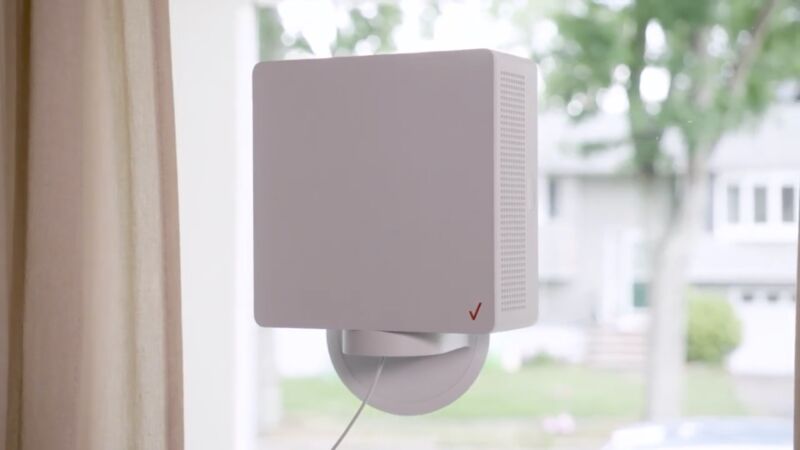More 5G disappointment —
5G Home is barely available even in the few areas that have Verizon mobile 5G.
Jon Brodkin
–

Enlarge / A Verizon 5G Home router/receiver mounted on a window.
If you’re hoping to get Verizon’s 5G Home Internet service in the near future, you’re probably out of luck—even if you live in one of the few cities where it’s already deployed. More than two years after its unveiling, Verizon 5G Home is for sale in parts of eight cities, with an emphasis on “parts.” PCMag’s Sascha Segan used the 5G home service’s address-lookup tool to find out how prevalent 5G Home is in areas that have Verizon 5G mobile access, and the results were disappointing.
“Since the company doesn’t offer a coverage map for its home service, we pumped more than 400 Chicago and Minneapolis addresses through the Verizon 5G Home address finder and discovered that the home service has even less coverage than the mobile service does,” PCMag wrote in the article published yesterday.
Segan’s PCMag article includes several maps that show a large majority of houses in Verizon’s 5G mobile coverage areas cannot get 5G Home. Verizon 5G mobile has limited reach to begin with because it relies on millimeter-wave frequencies that don’t travel far and are easily blocked by walls. The ad industry’s self-regulatory body recently urged Verizon to stop running ads that falsely imply the carrier’s 5G mobile service is available throughout the United States because “Verizon’s 5G coverage is primarily restricted to outdoor locations in certain neighborhoods and varies from block to block.”
Verizon 5G mobile is more prevalent in major commercial areas than on smaller residential streets, which partly explains the limited 5G Home availability. But PCMag found bad results pretty much everywhere it looked and said that the “most striking disappointment came when we looked at Chicago’s wealthy, densely populated Lakeview neighborhood. Not only did coverage not stretch beyond Verizon’s very limited mobile 5G map, addresses that appeared to be right on 5G corridors kept getting rejected.”
PCMag also recently found that AT&T’s mobile 5G is slower than its 4G in 21 out of 22 cities tested.
New equipment will help, but rollout is slow
Verizon is trying to expand 5G Home availability with an all-in-one router/receiver that it says “has a longer range from a radio standpoint so more households will be covered.” It uses a Qualcomm QTM527 antenna module. Verizon also said the new equipment can provide speeds of up to 1Gbps, although the company also promised up-to-1Gbps speeds two years ago.
Verizon urged patience with the 5G Home rollout, noting that the new hardware was just announced on Thursday last week and that the company is being conservative in bringing on new customers. Verizon’s statement to PCMag said:
With our new equipment, customers will have an even better 5G Home experience. Keep in mind, we’re only on day 3 with the new equipment and our new 5G Home markets. To ensure our customers have the best experience, the website is currently being a bit conservative with who is getting qualified. That said, we’re expecting performance improvements and the addition of new small cells will continue to improve both coverage area and speeds.
We asked Verizon for more detail, including the number of homes that can be served by 5G Home, and will update this article if we get a response. Besides Chicago and Minneapolis, the cities where Verizon 5G Home is available are Detroit, Sacramento, Los Angeles, Houston, Indianapolis, and St. Paul.
More than a year ago, Verizon said it plans to bring 5G Home “in due course” to every market where it deploys 5G mobile service. As of now, Verizon 5G mobile is available in parts of 36 markets. Twenty-eight of them don’t have any 5G Home coverage.
Verizon 5G Home can be deployed via an antenna on a roof, requiring a visit from a Verizon technician. But typically, the service is installed by users with the receiver mounted on the inside of a window—preferably upstairs to get a better connection. “The Verizon 5G Home Internet service requires a direct line of sight between our 5G cell site and your residence,” Verizon says in an FAQ. “Because of this, some residences on the same block may have the 5G Home Internet coverage, while others may not.”
5G Home costs $70 a month if you don’t have a Verizon Wireless mobile plan, or $50 a month if you are a mobile subscriber. While maximum download speeds are 1Gbps, Verizon says that typical download speeds are 300Mbps, and typical upload speeds are 50Mbps. 5G Home falls back to 4G LTE when a millimeter-wave signal is not available.
Slower 4G home service more widely available
Verizon also offers a 4G LTE home Internet service. The 4G service is slower than 5G Home, with advertised speeds of 25Mbps, but you have a much better chance of being able to subscribe. In a separate article, PCMag mapped out the ZIP codes where Verizon says 4G-based home Internet is at least partially available and found it has a much larger coverage area than 5G Home. That isn’t surprising because Verizon 4G relies on low- and mid-band frequencies that can cover longer distances and penetrate walls better than Verizon’s high-band spectrum.
You can check whether Verizon’s LTE Home Internet service is available at your address at this page. Verizon charges $60 a month for the LTE home service if you’re not a Verizon mobile customer, or $40 if you do have a mobile subscription. There is no monthly data cap on either the 4G or 5G home service.

